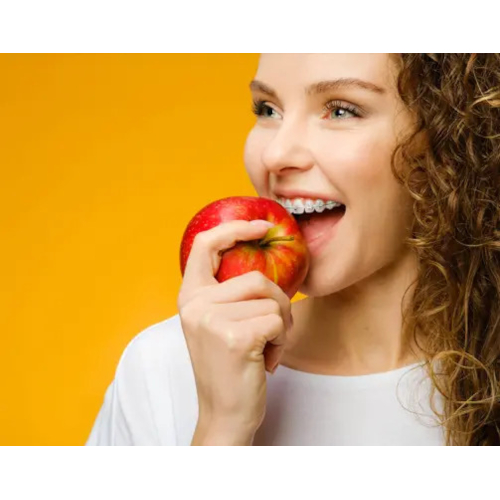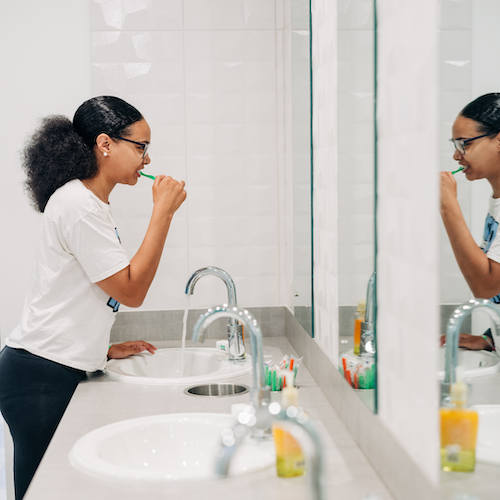Life With Braces
We want you to be informed about you or your loved one's orthodontic and dental needs. We will address all of your orthodontic concerns. During your orthodontic treatment, there's a few things you should know. Read below on how to take care of your orthodontic appliances during treatment.

Eating With Braces
It’s not going to be easy at first, and in the beginning foods you can eat will be limited. You’ll want to stick to foods that are soft, fluffy and easily mashed up. Pancakes, oatmeal, bananas, soups, cooked vegetables, applesauce, mashed potatoes, mac & cheese, and soft ice cream – just to suggest a few. Stay away from foods that are hard, crunchy, sticky or tough.
There are a few tricks around some problem foods. You can cook your vegetables to make them softer, cut your corn off the cob, and slice apples and sandwiches into small, bite sized pieces.
Although braces have become sturdier with modern technology, it’s still important to be careful not to damage them. Certain foods can damage braces components like the rubber bands, wires, or even the bracket itself. Generally, avoid all foods that are sticky, hard, or chewy. Soft foods are most recommended for those who wear braces because they are gentler on braces hardware.
If you’re in doubt about a particular food, ask the doctor.
Foods to Avoid
Emergency Care
For situations requiring immediate medical attention, you should contact your doctor or local emergency medical services.
For orthodontic-related emergencies, our office is here to help. Most emergency situations can be temporarily taken care of at home! Usually loose brackets and wires that are causing some discomfort or poking can be covered in wax or pushed back into place. Loose and poking wires can be manipulated using tweezers or a pencil eraser, or can be clipped with nail clippers. It’s still important to call the office and set up an appointment to have the issue corrected.
In the event of a more severe issue (an appliance breaks, a wire slips loose, or is preventing the mouth from opening or closing), call our office to schedule an appointment and have the problem taken care of right away.
Keep in mind that there may be some discomfort for a few weeks after getting your braces on and for several days after an adjustment. In these situations, rinsing with salt water or taking an over-the-counter pain reliever may alleviate the soreness.


Good Brushing
Before you brush, rinse with water. This can help loosen any food lodged in and around the braces. When you’re ready to brush, start by brushing at the gumline at a 45-degree angle. After brushing the gumline, place the toothbrush on top of the brackets, angling down to brush on top of each bracket. Then, reposition the toothbrush to brush the bottom of the bracket and the wire, angling the toothbrush up. Go slowly. Make sure to brush every tooth at the gumline as well as above and below the brackets. This will ensure you’ll reach the majority of the tooth’s surface and help to remove plaque and food debris. Even kids who are old enough to brush on their own may require help until they are comfortable properly angling the toothbrush and have learned how to brush their teeth with braces.
Cleaning Between Teeth
Flossing is a crucial step toward keeping teeth healthy. Use a floss threader to make flossing with braces easier. Soft picks can help brush very tight spaces. After brushing, you can help prevent cavities by rinsing with a mouthwash like Colgate Total Advanced Health, which removes 24x more bacteria for a healthier mouth.
Taking care of teeth with braces requires diligence. Kids in braces don’t always have the discipline they need to care for their teeth, so it’s important for parents to encourage and help with tooth care. And, even with braces on, kids should see their dentist twice a year for cleanings and checkups.
Retainers
Once orthodontic treatment has been completed, the use of retainers after braces is a very important part of the continuing maintenance of teeth and will go a long way toward keeping the same bite and smile that the braces formed over the previous few years. Your orthodontic treatment at Alexandria Orthodontics includes a set of upper and lower retainers. If you want to keep your beautiful straight teeth after braces come off, retainers have to be worn every night! Teeth will quickly shift back to where they were most comfortable before treatment unless retainers are worn.
We recommend brushing your retainers after you take them out. Retainers can be cleaned with your toothpaste (non-whitening pastes that do not contain harsh granules), simple hand soap, or even denture cleaners for a good, thorough clean! Do not allow your retainers to sit in hot water or put in the dishwasher as this will deform your retainers.
Always keep your retainers in a case when not in your mouth. Never keep them in a napkin! (This is the most common reason retainers are accidentally thrown away.) If you lose or break a retainer, please contact the office as soon as possible. A lapse in retainer wear is an opportunity for teeth to shift out of place.

Foods to Avoid
Certain foods can damage braces
- Popcorn
- Nuts
- Hard taco shells
- Sticky and hard candy
- Gum
- Ice
- Corn chips
- Pretzels
- Hard cookies or crackers
- Sticky or hard chocolate
Try to avoid biting into hard foods with your front teeth. When possible, cut up these hard foods into smaller pieces:
- Raw vegetables
- Croutons
- French/Italian bread
- Fruit
- Hard rolls
- Thin crust pizza
- Meat
- Burgers
- Sub sandwiches
- Corn on the cob
